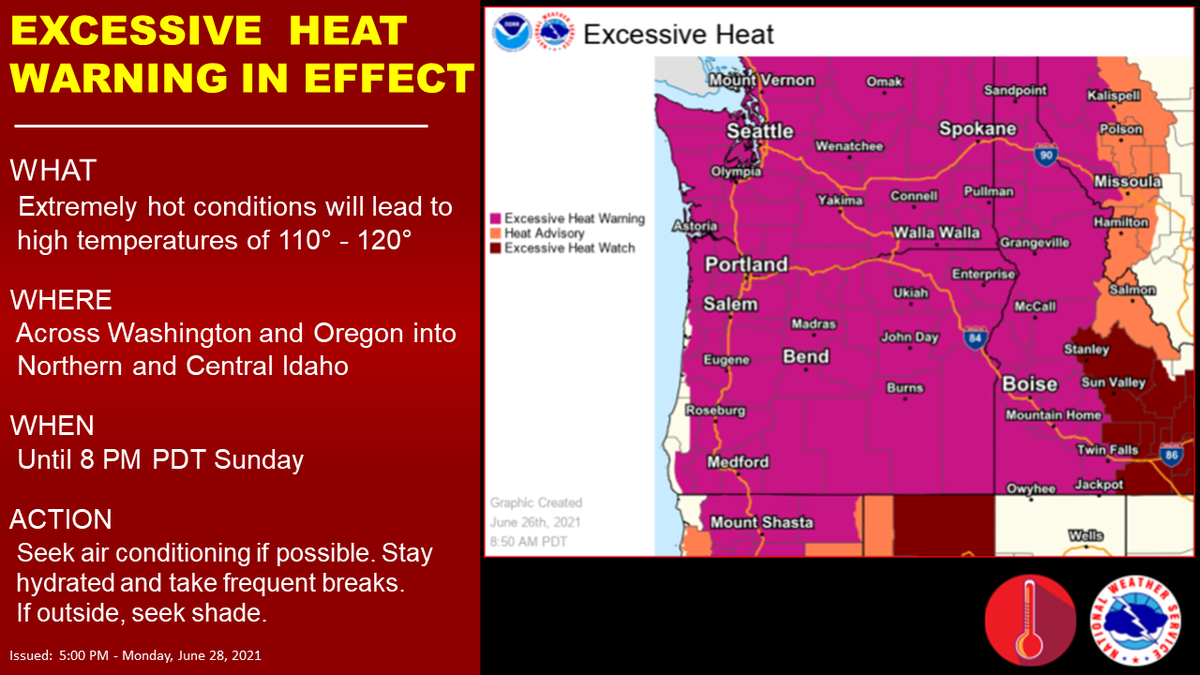Northwest temperatures rise, records fall — again – on hottest day of intense heat wave

SEATTLE (AP) — The hottest day of an unprecedented and dangerous heat wave scorched the Pacific Northwest on Monday, with temperatures obliterating records that had been set just the day before.
Seattle hit 108 degrees Fahrenheit (42 Celsius) by evening — well above Sunday’s all-time high of 104 F (40 C). Portland reached 116 F (46.6 C) after hitting records of 108 F (42 C) on Saturday and 112 F (44 C) on Sunday.
Bend Airport recorded a 108-degree reading Monday afternoon, breaking the city's all-time record of 106, set back on August 1, 1916. The city issued an emergency order, paving the way for more cooling centers and banning the use (but not sale) of fireworks
Redmond Airport reached 110 degrees, eclipsing the all-time record of 108 set Sunday. Other late-afternoon readings included 112 at Warm Springs, 109 in Madras, 106 in Prineville and Sisters and 104 in Sunriver. All but Sisters and Prineville represent all-time records, NewsChannel 21's Katie Zuniga said.
And then there's the record temperatures of 118 degrees at The Dalles Municipal Airport (the Columbia Gorge Regional Airport) in Dallesport, Washington, across the Columbia River from The Dalles. That tied the Washington state all-time record temperature first set in Wahluke on July 24, 1928 and matched at Ice Harbor Dam on August 5, 1961.
The temperatures were unheard of in a region better known for rain, and where June has historically been referred to as “Juneuary” for its cool drizzle. Seattle’s average high temperature in June is around 70 F (21.1 C), and fewer than half of the city’s residents have air conditioning, according to U.S. Census data.
The heat forced schools and businesses to close to protect workers and guests, including some places like outdoor pools and ice cream shops where people seek relief from the heat. COVID-19 testing sites and mobile vaccination units were out of service as well.
The Seattle Parks Department closed one indoor community pool after the air inside became too hot — leaving Stanlie James, who relocated from Arizona three weeks ago, to search for somewhere else to cool off. She doesn’t have AC at her condo, she said.
“Part of the reason I moved here was not only to be near my daughter, but also to come in the summer to have relief from Arizona heat,” James said. “And I seem to have brought it with me. So I’m not real thrilled.”
The heat wave was caused by what meteorologists described as a dome of high pressure over the Northwest and worsened by human-caused climate change, which is making such extreme weather events more likely and more intense.
Zeke Hausfather, a scientist at the climate-data nonprofit Berkeley Earth, said Monday that the Pacific Northwest has warmed by about 3 degrees F (1.7 degrees C) in the past half-century. That means a heat wave now is about 3 degrees warmer than it would have been before — and the difference between 111 degrees and 114 is significant, especially for vulnerable populations, he noted.
“In a world without climate change, this still would have been a really extreme heat wave,” Hausfather said. “This is worse than the same event would have been 50 years ago, and notably so.”
The blistering heat exposed a region with infrastructure not designed for it, hinting at the greater costs of climate change to come. Blackouts were reported throughout the region as people trying to keep cool with fans and air conditioners strained the power grid.
“We are not meant for this,” Washington Gov. Jay Inslee said of the Pacific Northwest in an interview Monday on MSNBC. “This is the beginning of a permanent emergency ... we have to tackle the source of this problem, which is climate change.”
In Portland, light rail and street car service was suspended as power cables melted and electricity demand spiked.
Heat-related expansion caused road pavement to buckle or pop loose in many areas, including on Interstate 5 in Seattle. Workers in tanker trucks in Seattle were hosing down drawbridges with water at least twice a day to prevent the steel from expanding in the heat and interfering with their opening and closing mechanisms.
Democratic U.S. Sen. Maria Cantwell said in a statement Monday that the heat illustrated an urgent need for the upcoming federal infrastructure package to promote clean energy, cut greenhouse gas emissions and protect people from extreme heat.
“Washington state was not built for triple digit temperatures,” she said.



